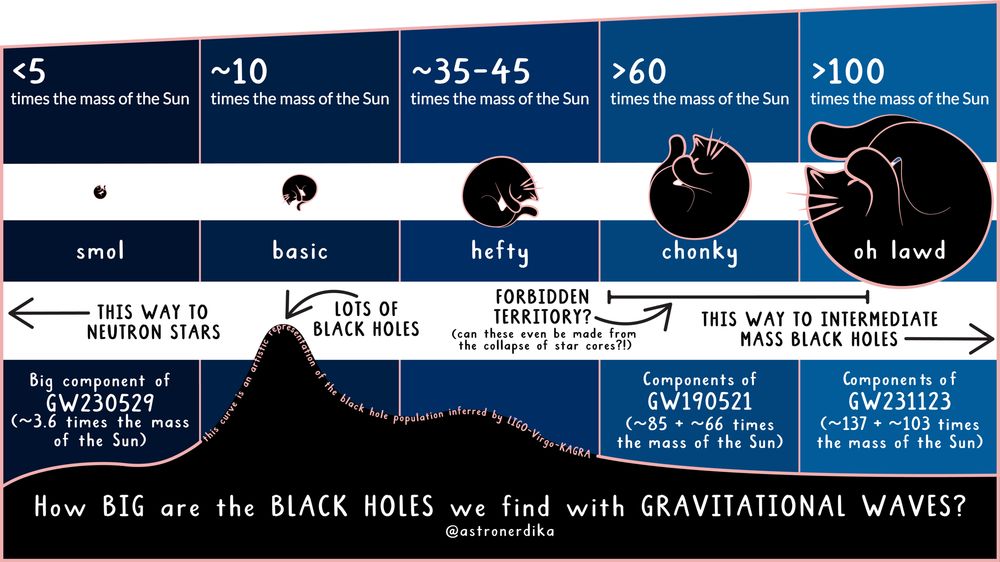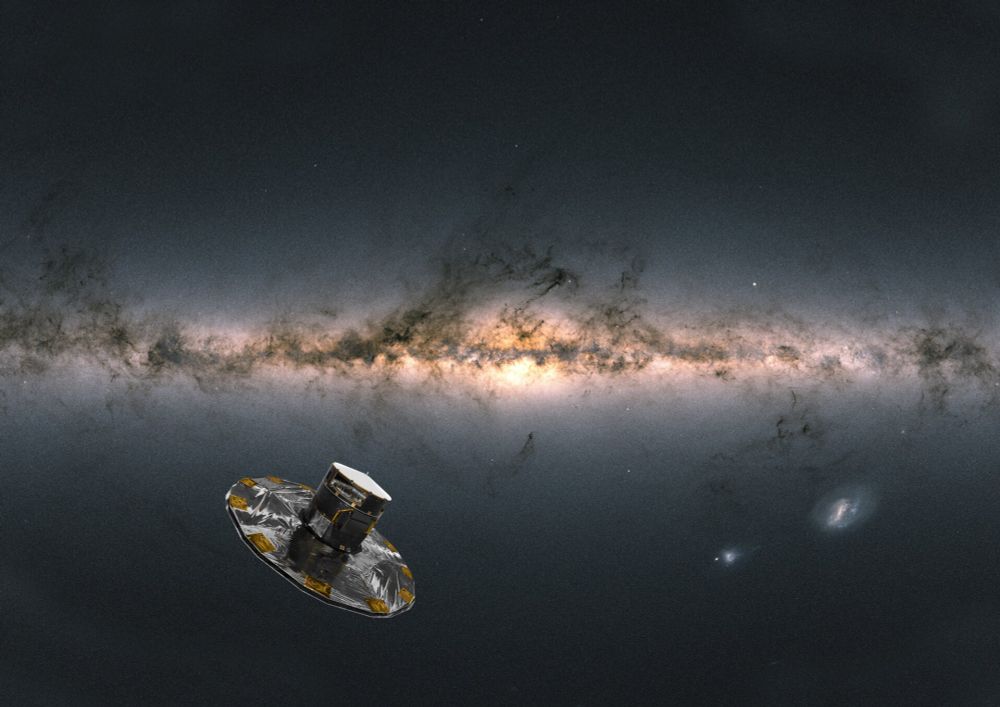
A portrait of Einstein and Hawking with a binary black hole in between. It is rather dramatic, and shows cool light-bending effects.
"Ten years ago, scientists heard the universe rumble for the first time. That first discovery of gravitational waves began a new era of astronomy."
@simon-stevenson.bsky.social writes about gravitational-wave astronomy today
theconversation.com/10-years-ago...
#GW10Years 🔭🧪⚛️
🖼️: C Knox
12.09.2025 21:29 — 👍 30 🔁 11 💬 0 📌 0
Tips and resources for those who would be interested in pursuing an astro PhD outside this US and applying for programs this Fall, put together by Floor Broekgaarden, Ana Lam, Enrico Ramirez-Ruiz, Deana Tanguay! 🔭 docs.google.com/document/u/0...
15.08.2025 22:57 — 👍 77 🔁 37 💬 5 📌 2

An infographic titled "How BIG are the BLACK HOLES we find with GRAVITATIONAL WAVES?" by @astronerdika. The graphic displays a range of black hole masses detected via gravitational waves, categorized by their size in solar masses (mass of the Sun) and represented with playful cat-like black hole illustrations.
The categories from left to right are:
1. "<5 times the mass of the Sun"
- Labeled "smol"
- Very small black hole illustration represented by a curled up black cat
- Arrow pointing left: "THIS WAY TO NEUTRON STARS"
- Example: "Big component of GW230529 (~3.6 times the mass of the Sun)"
2. "~10 times the mass of the Sun"
- Labeled "basic"
- Slightly larger black hole cat illustration
- Caption: "LOTS OF BLACK HOLES"
3. "~35–45 times the mass of the Sun"
- Labeled "hefty"
- Bigger black hole cat illustration
- Continues the idea of a populated range
4. ">60 times the mass of the Sun"
- Labeled "chonky"
- Large black hole cat illustration
- Caption: "FORBIDDEN TERRITORY? (can these even be made from the collapse of star cores?!)"
- Example: "Components of GW190521 (~85 + ~66 times the mass of the Sun)"
5. ">100 times the mass of the Sun"
- Labeled "oh lawd"
- Very large, curled-up black hole cat illustration
- Arrow pointing right: "THIS WAY TO INTERMEDIATE MASS BLACK HOLES"
- Example: "Components of GW231123 (~137 + ~103 times the mass of the Sun)"
Below the categories is a stylized black curve representing the inferred population of black holes detected by LIGO-Virgo-KAGRA. It rises sharply in the "basic" range and falls off toward the "hefty" and "chonky" ranges, with a note reading:
"this curve is an artistic representation of the black hole population inferred by LIGO-Virgo-KAGRA."
This infographic draws from the “Chonky Cat” meme.
Heard the latest news from the LIGO-Virgo-KAGRA collaboration? We detected the collision of the most massive pair of black holes so far: #GW231123 weighing in at ~137 + ~103 times the mass of the Sun!
So to celebrate, here’s a handy chart ✨
Just how chonky are these black holes? 🤔
26.07.2025 10:42 — 👍 536 🔁 152 💬 15 📌 15

Statistical Machine Learning for Astronomy -- A Textbook
This textbook provides a systematic treatment of statistical machine learning for astronomical research through the lens of Bayesian inference, developing a unified framework that reveals connections ...
An absolutely fantastic textbook on statistics and machine learning by Prof. Yuan-Sen Ting came out this week - and it's free! #astromethods ☄️
I had a read and it's incredibly comprehensive and well-written - I expect this to become *the* foundation book on stats & ML basics in astro.
19.06.2025 18:34 — 👍 132 🔁 35 💬 8 📌 2
@bot.astronomy.blue signup
26.05.2025 13:08 — 👍 1 🔁 0 💬 1 📌 0

Promising hints of life found on distant planet K2-18b
Scientists find new but tentative evidence that a faraway world orbiting another star may be home to life.
An astonishing headline reporting on new observations from a team led to Nikku Madhusudhan claims they’ve found ‘hints of life’ on a planet orbiting a dwarf star some 124 light years away. What’s going on? (1/n) www.bbc.co.uk/news/article... 🔭 🧪
17.04.2025 03:24 — 👍 852 🔁 340 💬 26 📌 117
Huge Congratulations! @emilyjogriffith.bsky.social 🤎
01.04.2025 04:52 — 👍 1 🔁 0 💬 0 📌 0
Astrophysicist | Associate Professor & UKRI FLF at the Institute for Computational Cosmology, Durham | Interested in: galaxies; dynamics; bars; dark matter; science4peace; cats; (not necessarily in that order) | Cypriot #κυπραία #kıbrıslı
Sept. 15-19, 2025 - Vienna (Austria) ✨🌌
Topics: Galactic and Extragalactic Star Formation, Structure & Dynamics of the ISM, IA and ML
website: https://stellarorigins2025.univie.ac.at/
Posts under the hashtag: #stellarorigins2025
🕵️ Investigator of ripples in space-time | Astrophysicist
✨ Postdoc fellow | CIERA + Adler Planetarium 🇺🇸
linktr.ee/astronerdika | 🇦🇺🇱🇰(she/her)
Astronomer interested in star formation and statistics. Senior Lecturer at the University of Hertfordshire. Formerly Caltech, Universidad de Valparaíso, and Penn State. https://star.herts.ac.uk/~kuhn/
Get ready for a new era in astronomy and astrophysics with Rubin Observatory!
Para español siga a Instagram: http://instagram.com/rubin_observatory
Official Account of the EAS Annual Meeting #EAS2025Cork
Astronomer 🌌, professor at the U of Utah, mom of 2 littles. Exploring, hiking, camping, cooking, reading. Sci-fi and period romances. Definitely not writing social media bios.
Extragalactic astrophysicist. Assistant Prof @ IST Austria - PI of ERC StG-2022 AGENTS. PhD Leiden 2018, Zwicky fellow @ ETH Zurich,2018-2023.
Astronomer @ MIT. First graduating class of Yale-NUS College, Singapore. 🇮🇳 →🇸🇬 →🇺🇸 https://rohannaidu.github.io/
#50YearsOfESA: we're the European Space Agency, keeping you posted on European space activities.
Please see our Privacy Notice: https://esa.int/connectwithus
Astrophysics, Ashoka University, India. Formerly @IUCAAstro Pune. Alumnus Presidency College Calcutta, U Oxford & Cambridge. Posts personal.
✨ PhD candidate at Swinburne University of Technology | OzGrav
🔭 Time-domain astronomy | Hunting for kilonovae
🖤 Token workplace emo
🌙 she/her
Surrey astrophysicist. Understanding the formation history of our Milky Way through dynamics and chemistry. Talk about papers on the Starxiv.
A podcast where Payel Das (@payeldas.bsky.social) and Michelle Collins (@runningastronomer.bsky.social) discuss papers from astroph
Starxiv.com
Spotify - https://shorturl.at/xdTFw
Apple - https://shorturl.at/nKFNj
RSS - https://rss.com/podcasts/starxiv
NZ theoretical astrophysicist studying exploding binary stars. Sci-fi addict, feminist, non-binary femme. Pronouns: she/her/they. All views my own.
Bad Astronomer (formerly @BadAstronomer), SciCommer, Dork. Crash Course Astronomy guy. He/him. Newsletter: badastronomy.beehiiv.com
I'm self-employed so my opinions do in fact represent my company's.
Official Mirroring APOD BOT for Bluesky.
https://apod.nasa.gov/apod/lib/about_apod.html
Src:
https://apod.nasa.gov/apod/astropix.html
http://star.ucl.ac.uk/~apod/apod/astropix.html
Maintained by @shinyakato.dev
Assistant Professor of Astrophysics, studying the evolution of galaxies, University of Cambridge, Fellow of St Edmunds College 🇨🇭🇺🇲🇰🇷🇬🇧






